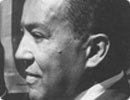| |
||
Throughout the twentieth century, Harlem has served as the home and key inspiration to generations of novelists, poets, musicians, and actors. The pace of New York City, the blend of backgrounds of the people who settled in Harlem, and the difficulties associated with living in Harlem were among the experiences that found expression in theater, fiction, and music, among other art forms. |
||
 |
Robert O'Meally, in a video interview, discusses stride piano and Harlem's other great musical traditions and why that richness couldn't have emerged anywhere else. View |
|||
 |
A. Philip Randolph (1889–1979) President of the Brotherhood of Sleeping Car Porters, recalls his interactions with the leaders of the Harlem Renaissance. View |
|||
 |
Farah Griffin, in a video interview, remembers best-selling novelist Ann Petry, whose work as a reporter, actress, and consumer activist in Harlem is reflected in her rich descriptions of the neighborhood and its people. View |
|||
 |
Dorothy Height, the civil-rights leader, moved to Harlem in 1929. She went club-hopping with W. C. Handy, and attended plays at the Lafayette Theatre. View |
|||
 |
Casey Blake, in a multimedia presentation, reflects on the disappointments of the Harlem Renaissance. Despite the explosion of white interest in Harlem, African American culture continued to be misunderstood. View |
|||
 |
Langston Hughes was a pioneering writer and Columbia student. The New Yorker magazine reflected on Hughes at Columbia in a piece published after his death in 1967. View |
|||